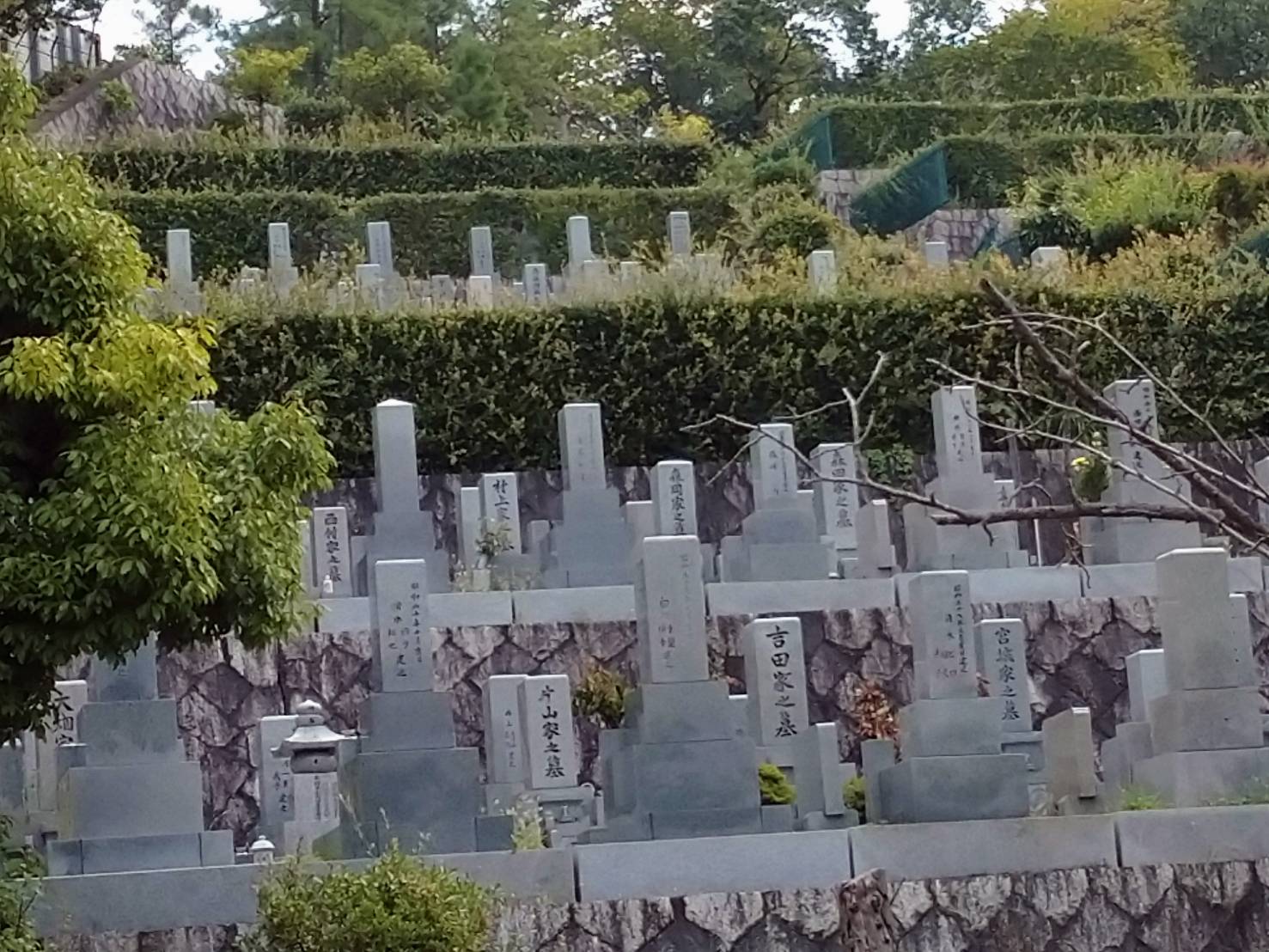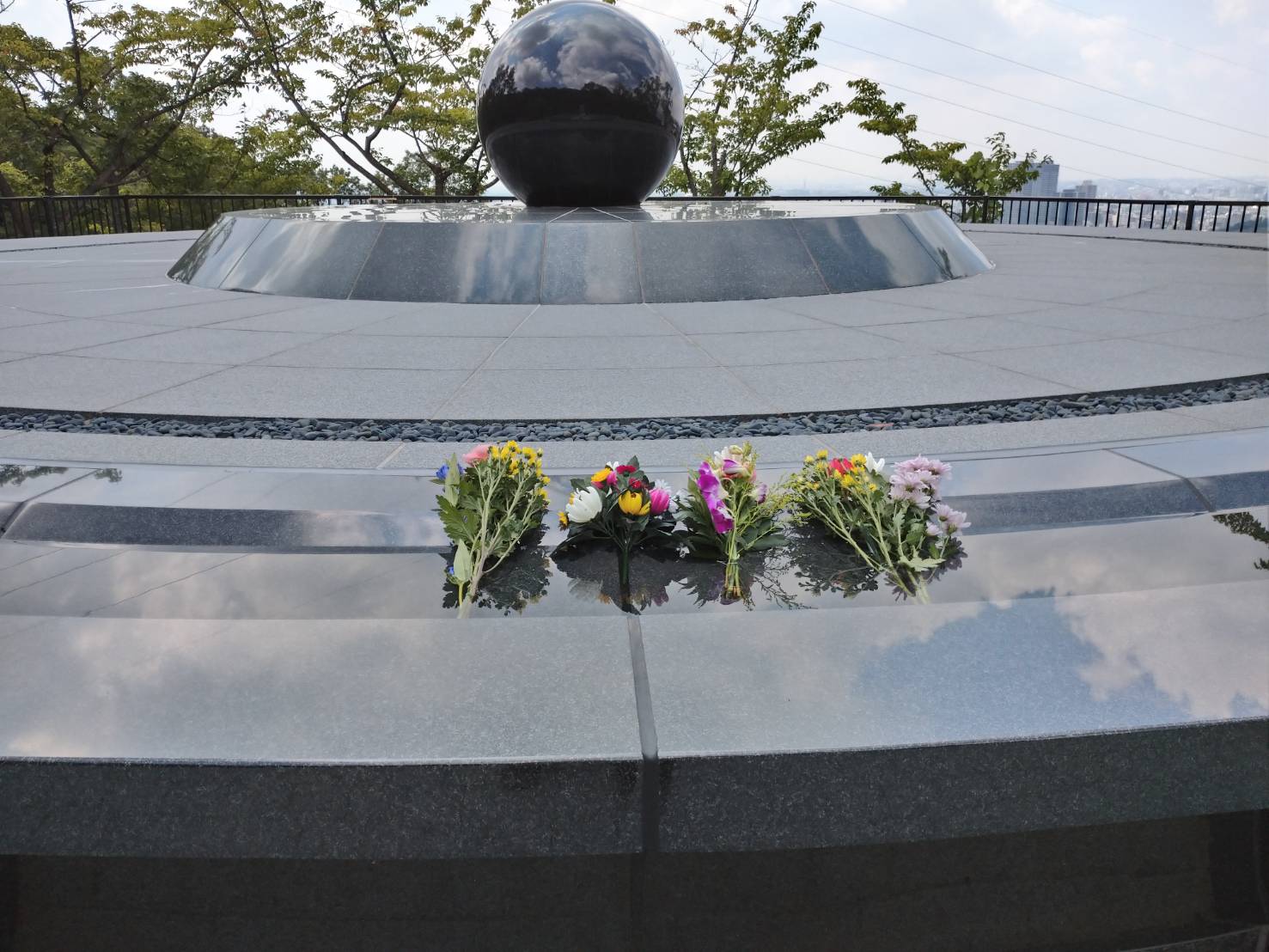Article begins
The typical inscription on most Japanese tombstones does not show the names of the deceased. It says instead “Ancestral grave of the X family,” reflecting a lingering political heritage of the Meiji oligarchy (1868–1912). The imperial government established the ie (家), or the patrilineal family to which every citizen must belong, and mandated ancestor worship with the family grave as its locus to ensure the ie continuity (Tsuji 2002, 177-199). Hence, generations of family members in the direct line of descent—the family head, his wife, their heir, the heir’s wife, and so on—are buried together. Their descendants are responsible for looking after the family grave and worshipping their ancestors. A tale of two cemeteries in northern Osaka shows us much about recent changes in Japanese mortuary traditions.
The first is a municipal cemetery established in 1969. It had 4,000 graves by 1987 and was expanded to 6,364 in 2000. On the large terraced hillside overlooking the skyscrapers of Osaka City, one can see countless rows of traditional three-tier graves in which the cremains of several generations of family members are interred. Most inscriptions on them say “X family’s ancestral grave.” A few newer gravestones are carved with Chinese characters, such as serenity (寂), dream (夢), and appreciation (感謝).

Image description: Numerous stone grave markers line different levels of a cemetery. They all have wide, broad bases with smaller tiers stacked atop each other. The stone on the top tier of each grave is taller and narrower than those underneath and has a vertical inscription on it.
Caption: Traditional three-tier graves at the Municipal Cemetery. Yohko Tsuji
More notable modifications of burial traditions occurred in 2019. The municipal government built a large monument to collectively entomb the cremains of 14,000 unrelated people in order to economize the burial space and to memorialize those entombed, thereby relieving each family from maintaining their own grave and worshipping their ancestors there. This monument helps to solve two major death-related problems in contemporary Japan: an increasing number of deaths as the baby boomer generation ages, and a growing number of people who have no grave or no family members to take care of their grave and afterlife.

Image description: A black sphere sits atop a raised circular platform that rests on a tiled circular pattern of dark grey stone. On the edge of the largest circle are four bouquets of flowers with colorful blossoms of yellow, pink, orange,and white.
Caption: Monument for Collective Burials at the Municipal Cemetery. Yohko Tsuji
The second cemetery, established in 2012 and known as sakurasō (桜葬) or a cherry blossom cemetery, offers a different approach to resolve the same problems. Adopting the principle of jumokusō, or tree burials (Boret 2014), no tomb stones or monuments exist at the park-like site of this cemetery. Instead, cherry trees are planted to signify six burial areas, where unrelated people’s cremains are buried without markers. Each burial area has a few stones with small metal plates on them bearing varying inscriptions: some show the deceased’s names and dates of birth and death, and others include words of thanks or personal messages, such as “Good-bye. It was an interesting life.” A service to commemorate all of the dead is held annually.
Though the land of sakurasō cemetery belongs to a Buddhist temple, it is managed by a nonprofit organization (NPO) and is available to anyone regardless of religious belief. Like the monument at the municipal cemetery, these graves require neither maintenance nor descendants. The NPO offers support both before and after death by performing tasks that have traditionally been undertaken by next of kin but have become harder to do: checking on older people living alone, assisting with hospitalization, serving as the stand-in chief mourner for a funeral, and so on. The NPO also organizes regular meetings of those who will be buried together, creating a community of hakatomo which literally means “grave friends.”
As these cemeteries demonstrate, mortuary tradition is evolving and generating new types of practices.
This tale of two cemeteries illustrates the unmistakable transformations in Japanese mortuary tradition (Tsuji 2018, 17-30). They reflect and adapt to the changes in Japanese families, neighborhoods, workplaces, economy, ecology, and demographics that have occurred in the last half a century. Particularly, the family’s central role has diminished. Instead individual choices and decisions have become more important. Despite myriad societal changes however, death continues to be significant in people’s lives. Indeed, over 33 million websites are available to check the cost of a cemetery lot. Choosing a nontraditional grave and entrusting the care of the afterlife to extrafamilial entities, such as the municipal government and the sakurasō cemetery management, provides a tenable means of securing care of death and the afterlife. It does not necessarily mean that people have stopped practicing mortuary rituals. Rather, their nonconventional choices of graves and conformity to mortuary tradition coexist. During biannual religious weeks in the spring and the fall, extra buses are operated to the municipal cemetery for people who worship their ancestors. Some family members regularly visit the sakurasō cemetery, including on death anniversaries of their loved ones.
As Japanese society is rapidly aging, death and dying are becoming even more visible with the mass media constantly featuring pertinent information and people’s concerns about shūkatsu (終活), or preparation for death and the afterlife, escalating. Furthermore, as these cemeteries demonstrate, mortuary tradition is evolving and generating new types of practices.
Another such example is the practice of burial with one’s pet. Traditionally, pets are not allowed to be entombed with humans. Behind this ban is the Buddhist worldview, which places animals and humans in separate stages of the reincarnation cycle. However, in the last few decades, this clear demarcation has been blurred as pets have become increasingly regarded as indispensable family members. Called uchi-no-ko, or “our child,” just like human progeny, the pet shares daily life with many Japanese inside their residences rather than in a kennel outside. Uchi-no-ko is fed pet and human food rather than the leftovers given in the old days. People also clothe their pets with sweaters, caps, and socks and have them groomed regularly. They buy pet medical insurance and take them to veterinarians for illness and injury, not to mention check-ups and shots.
For its persistence, tradition must change, adapting to social transformations and accommodating people’s altered needs.
When uchi-no-ko dies, many Japanese have a funeral, hiring a pet funeral operator or asking a Buddhist priest to chant a sutra. They bury their fur child in a pet cemetery and visit it frequently, dismissing a more customary method of calling the health department to have the pets’ remains incinerated or, if the family has a yard, burying them in a hidden corner.
These pet parents suffer the loss of their children and are concerned about their pets’ afterlives as much as their own. Because the burial of pets in human graves is not permitted at most cemeteries, the everlasting separation from their pet and the uncertainty of the pet’s afterlife aggravate their grief. Buddhist priests frequently receive questions, such as: “Can uchi-no-ko rest in peace or go to heaven?” and “Can I and uchi-no-ko meet again after my death?” These pet owners strongly wish to be reunited with their pet in the same grave after their death. To address such sentiments, some cemeteries, including the aforementioned sakurasō cemetery, allow humans and pets to be buried together.
The tale of two cemeteries and the burial with one’s pet attest to the malleability of tradition. For its persistence, tradition must change, adapting to social transformations and accommodating people’s altered needs. Japanese mortuary tradition continues to evolve to handle death, “the supreme and final crisis of life” (Malinowski 1948, 47), in a contemporary world awash with immense changes.
Yohko Tsuji is an adjunct associate professor of anthropology at Cornell University and the author of the forthcoming book, Through Japanese Eyes: Thirty Years of Studying Aging in America. She has conducted fieldwork in America, Japan, and Thailand, and published articles on aging, death, conception of time, and social change.
The SEAA column is currently accepting submissions. Please contact Shuang Frost ([email protected]) and Hanna Pickwell ([email protected]) with your essay ideas and comments.
Cite as: Tsuji, Yohko. 2020. “Changing Mortuary Practices in Japan.” Anthropology News website, August 13, 2020. DOI: 10.14506/AN.1471

